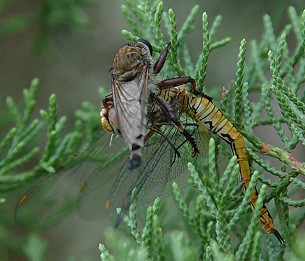
Robberfly taking a large dragonfly
I’ve started working on a long-term project to define who eats what and is eaten by whom. Published sources are not as much help as you might think, since they’re not really local and the local mix of food sources varies from both historical record (we have different plants, in different proportions, and thus different proportions of animals for the meat-eaters to prey on) and from published sources set in a different area.
It’s being every bit as difficult I suspected it would be. Critters do not all come and pose in front of the camera with an array of their food sources so consumption can be documented. Nor are they limited to the foods we put out. Killing a lot of native critters to do stomach content analyses (a very accurate way of finding out what *that* individual ate, but non-reproducible in that individual) isn’t something I want to do, or have the time and expertise to do anyway. So far I’ve photographed a lot of birds eating from mixed-seed offerings (every size from niger-thistle to millet to peanuts, including both cracked and whole kernel corn) and have documented a size range per species for the species I’ve photographed. I’ve looked at scat from raccoons, foxes, and coyotes to see what plants/animals they’re eating. I’m not an expert at IDing little tiny bones, so the big owl pellets I found told me only that the owl had eaten something with bones in it (which everyone knows anyway–but was that probable mouse a deer mouse, white footed mouse, white-ankled mouse–all of which we have–or some other mouse-sized critter?)
The fox scat is nearly all vegetable and insectile–if our foxes are catching mice, it’s certainly not as often as grasshoppers, beetles, other insects and their larvae–and they eat a fair amount of prickly pear fruit and various berries. Coyote scat has fur in it much more often–rabbit fur, even squirrel fur, and rodent fur (mice, cotton rats.)
By observation, squirrels are eating acorns (of course), pecans (of course) but also osage orange (Maclura pomifera, bois d’arc) “apples”, the buds of almost everything, and any larger grass seeds (for instance, from eastern gama if it’s growing close enough to brushy-woody cover.) They also raid the bird feeding stations, along with raccoons.
Competing for aquatic resources (when we have any water in the seasonal creek) are raccoons (crayfish, fish trapped in puddles, aquatic insect larvae) , turtles, and herons (mostly fish, but I saw one with a crayfish.) And when there’s enough water in the creek long enough, bigger fish after the smaller fish. One wet year, I watched a long-eared sunfish defend its nest from hungry striped-bass youngsters. On the small scale, every wildlife waterer (and the creek when it’s wet) has its complement of insect larvae–most of them predatory, a few grazers–tadpoles of Gulf Coast toads and/or leopard frogs. The creek in wet weather has crayfish of at least two species and all sizes–all of them hungry, too.
Dragonfly and damselfly larvae in the water eat anything they can catch (including mosquito larvae) and are themselves eaten by other aquatic predators; as adults in the air, they’re preying on other insects (mosquitoes, flies, smaller dragonflies) and preyed on by birds, robber flies, bigger dragonflies, and spiders. ..and the occasional frog. (I have a photograph of a small frog that has swallowed an odonate longer than the frog could easily handle…the posterior of the ode’s abdomen is sticking out its mouth.)
Over the years we’ve worked with this place, the invertebrates have increased in variety, as native plant diversity has increased…and it’s clear that the variety of foods available to wildlife at all size scales is also increasing–whether they eat bugs or berries or mammals.
Nothing’s definitive yet (may not be in our lifetimes, what with climate change and our schedules) but I certainly won’t ever have time to be bored, chasing down the elusive white-ankled mouse I’ve seen just once (eating millet from a bird-seed spread near a brush pile….but I didn’t get a photograph.)